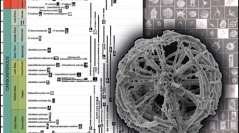

 Geodiversitas
39 (3) - Pages 503-531
Geodiversitas
39 (3) - Pages 503-531The current knowledge of Paleozoic radiolarian ranges, proposed zonations, and faunal assemblages that have been used in biostratigraphy over the past few decades is compiled herein. More than 90 assemblages can currently be readily recognized and many of these, although regional in their construction, have elements that can be correlated throughout a widespread paleogeographic area. A number of the existing zonations utilize robust, relatively common, and easily recognized morphotypes that may be easily identified when they are moderately or even poorly preserved. These schemes are readily applied to deciphering stratigraphic complexities in complex orogenic belts. Other assemblages and zones summarized herein have been developed from well preserved materials, such as that from concretions, and their applicability to dating chert sequences remains relatively untested. Uneven geographic coverage is apparent, where some time periods are largely represented by only a few well known regional radiolarian rich units. There is also uneven temporal coverage, where certain time periods have few data. Undoubtedly, the Permian schemes are the most robust, relying heavily on data acquired from Asia, and to a lesser extent North America. The present work provides an opportunity to address critical gaps and opportunities for future work in radiolarian biostratigraphy, and to provide information on the ranges of biostratigraphically useful genera and species employed in the Paleozoic which can be used for both correlation and understanding the evolution of this important group.
Paleozoic, radiolarians, zonation, evolution, biostratigraphy